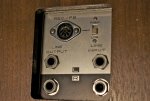SergiuM
Senior Member
I found some old Grunding mics in my basement. They LOOK like they would work pretty decently for drum recording (personal use), but i don't know anything about drum recording.. And does anyone know if i can find an adapter to convert that connector for a 3.5 mm jack? Thanks guys.
https://picasaweb.google.com/118129009361237468676/GrundigMicrophones?authkey=Gv1sRgCJ-zvNr9wJjMygE
https://picasaweb.google.com/118129009361237468676/GrundigMicrophones?authkey=Gv1sRgCJ-zvNr9wJjMygE


